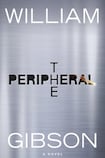
Altered states don’t always equate with narcotics. There’s a way of reading William Gibson’s work as a 30-year project in which cyberspace replaces the acid trip, future shock substitutes for the methamphetamine rush, and corporate paranoia is dope psychosis.
Gibson, raised in Virginia but resident in Vancouver for most of his working years, grew up in the shadow of the 1960s sci-fi revolutionaries: Samuel R Delany, Philip K Dick and the Dangerous Visions crew, an aggregation of countercultural futurists who rejected the space-colonisation epics of Robert Heinlein and Issac Asimov as right-wing American exceptionalism and took instead the modernists, the surrealists, Jorge Luis Borges and the beats as their icons.
Consequently, JG Ballard and William Burroughs probably had greater influence on Gibson's prose than any amount of dime-store space operas. The old guard inspired Star Wars, but Gibson and pals – Bruce Sterling, John Shirley, Rudy Rucker – were closer to Blade Runner.
The Peripheral, Gibson's 13th book, is published on the 30th anniversary of his debut, Neuromancer, a novel that recast the standard sci-fi hero as corporate hacker, and in the process provided the blueprint for The Matrix, Kathryn Bigelow's Strange Days and just about every other every high-concept near-future B-picture of the past few decades.
Neuromancer won the sci-fi triple crown of the Nebula, Hugo and Philip K Dick awards, inaugurated the term "cyberspace" and codified the cyberpunk aesthetic. Its protagonists wore leather and shades, sported prosthetic implants and were more likely to be found frequenting scuzzy clubs in the urban sprawl than colonising the galaxy.
Dark materials
Most of Gibson’s characters felt like they’d been dreamed up by Lou Reed after a night in Interzone; his visions were not merely dystopian: they were dirty, and they went against the sci-fi grain by casting female leads. Without
Neuromancer
– or John Shirley’s
City Come a
Walkin’
, or Alan Moore’s
Halo Jones
– no Lara Croft, no Lisbeth Salander.
Gibson consolidated his early success with two more books in the Sprawl series (Count Zero, Mona Lisa Overdrive), followed by the Bridge trilogy (Virtual Light, Idoru, All Tomorrow's Parties), all of which forecast virtual celebrity culture, corporate colonisation of the public consciousness and social media.
Then, in 2003, Gibson published his second major work, Pattern Recognition. The first of his novels set in the present day, it was an almost Victorian-paced novel that, if written by Don DeLillo or Thomas Pynchon, might have been hailed as the first great 9/11 novel. Now, after the Blue Ant trilogy that also included Spook Country and Zero History, Gibson has gone back to the future.
The Peripheral proceeds on twin tracks, dual narratives set in 2020 and the early 22nd century. Its main protagonist is a trailer-park gamer named Flynne, who, when subbing for her army-veteran brother, Burton, as a product tester, witnesses a murder that appears too real to be a simulation.
This trigger event propels the reader into a forensically imagined world that is at once spellbinding and incomprehensible, a maze of temporal streams (stubs) accessible by way of host bodies (peripherals) that facilitate a form of virtual time travel. Here servant-class homunculi and slave drones are ubiquitous, and the human race has been thinned out by the Jackpot, a slo-mo ecological and financial apocalypse. If you’re not a Gibson fan you’ll be bamboozled. If you are a Gibson fan you’ll be well used to being bamboozled.
Neuromancer might have been the most prescient novel of the late 20th century, but despite the standard heist plot it was not an easy read. Mike McCormack, maybe the only Irish writer who can claim any aesthetic affinity with Gibson, once described it as "incoherent in the way that an Old Testament prophet is incoherent, he's like a man straining for a language". Three decades later, Gibson makes no concessions. He drops us right in medias res, and it takes 50-odd pages to get a handle on what's going on.
The Peripheral features a large cast of supporting players that are little more than ciphers animated by sharp dialogue. There's Netherton, a high-flying publicist on the skids; Lowbeer, a metaphysical detective; and the various emissaries of Coldiron, a shadowy corporation with the power to move vast sums of cash into the past. Gibson is a brilliant observer of surfaces, of things, but his grasp of character is less penetrating.
Despite this The Peripheral is a formidable novel, and one that boasts just about the only plausible depiction of time travel in recent fiction. But it does suffer from slow pacing and a flat final-act climax. Gibson's early short stories – New Rose Hotel, Johnny Mnemonic, Burning Chrome, Fragments of a Hologram Rose – were visionary works, breaknecked-paced and daredevil .
The author is an elder statesman now, and it's unfair to expect him to summon the bravado of youth, but, for all its skill, vision and craft, The Peripheral might be a better book if it had been slash-cut edited and had its tempo jacked up by a couple of dozen bpm.
Peter Murphy's novels include John the Revelator












